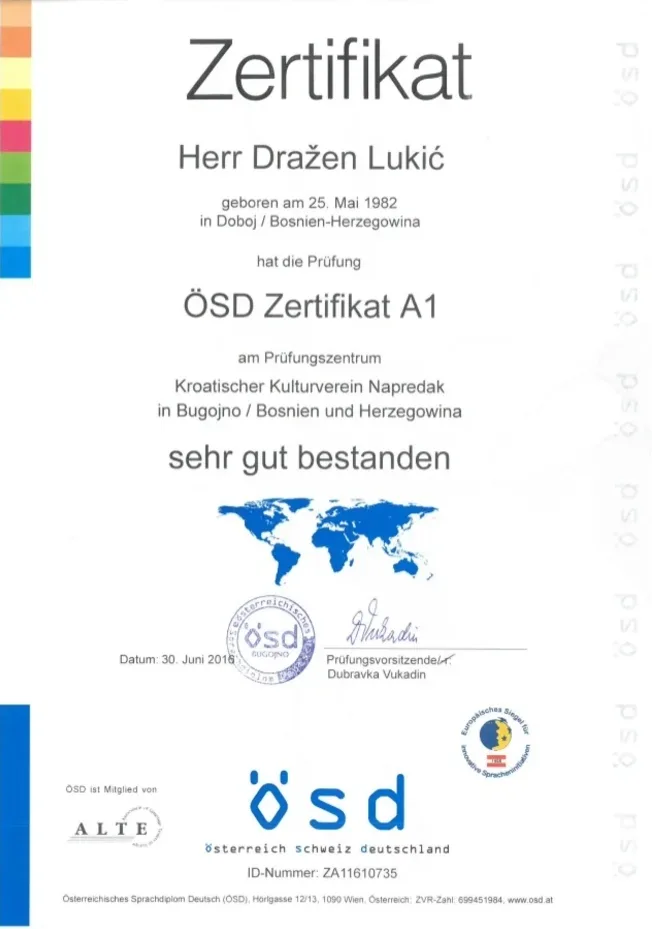5 ÖSD Certificate Lessons Learned From Professionals

Understanding the ÖSD Certificate: Your Gateway to German Proficiency
In a progressively globalized world, proficiency in numerous languages is an important property. For those interested in the German language, the ÖSD (Österreichisches Sprachdiplom) certificate stands apart as an acknowledged qualification. deutsch zertifikat österreich looks into what the ÖSD certificate is, its value, the structure of the tests, preparation ideas, and answers to often asked concerns.
What is the ÖSD Certificate?
The ÖSD certificate is a main language certificate issued by the Österreichisches Sprachdiplom Deutsch, or the Austrian Language Diploma in German. It evaluates the language proficiency of non-native speakers and adheres to the Common European Framework of Reference for Languages (CEFR). The ÖSD certifies language abilities ranging from A1 (novice) to C2 (skilled), covering 4 crucial competencies: reading, writing, listening, and speaking.
Value of the ÖSD Certificate
Getting an ÖSD certificate holds significance for different reasons:
Educational Opportunities: Many universities and academic organizations in German-speaking countries need proof of German language efficiency for admission. The ÖSD certificate functions as legitimate evidence of a candidate's language skills.
Employment Prospects: In a competitive job market, a recognized language certificate can boost a prospect's employability, especially in roles needing German as a primary language.
Migration Requirements: Some migration processes in German-speaking countries require language efficiency certificates. The ÖSD is extensively accepted by numerous authorities, making it a vital property for those moving to Austria or Germany.
Structured Learning: Preparing for the ÖSD certificate motivates learners to establish a well-rounded understanding of the language, assisting in both scholastic and everyday communication.
Structure of the ÖSD Exam
The ÖSD certificate incorporates various levels of assessment, aligning with the CEFR. The evaluation structure consists of the following components:
Levels Offered:
A1: Beginner
A2: Elementary
B1: Intermediate
B2: Upper Intermediate
C1: Advanced
C2: Proficient
Parts of the Exam:
The ÖSD tests are developed to assess the following language skills:
Listening Comprehension: Candidates listen to audio excerpts and respond to concerns to demonstrate understanding.
Reading Comprehension: This involves reading passages and reacting to concerns to reveal interpretation and understanding.
Composing: Test-takers engage in written jobs, such as composing letters or essays, to display their capability to articulate thoughts on paper.
Speaking: In this area, candidates take part in dialogues or monologues, showcasing their spoken communication skills.
Exam Format:
Examinations can take different formats, consisting of:
Paper-based: Traditional assessments carried out personally at designated screening centers.
Computer-based: Digital examinations available in some locations, offering versatility and benefit.
Preparing for the ÖSD Exam
Preparation for the ÖSD certificate requires a structured technique. Here are some reliable strategies:
Setting Up a Study Plan:
Assess Your Level: Determine your present efficiency level through practice tests.
Set Goals: Establish clear, possible objectives for each language skill (listening, reading, composing, speaking).
Daily Practice: Allocate time every day for language study and practice different skills to build a thorough command of German.
Resources for Study:
Language Courses: Consider registering in language courses, either in-person or online, particularly developed for ÖSD preparation.
Textbooks and Workbooks: Utilize materials that align with the CEFR levels and cover all 4 competencies.
Online Platforms: Websites, apps, and online forums provide interactive exercises and neighborhood assistance.
Test Exams: Familiarize yourself with the test format by practicing with sample questions and previous tests.
Engaging with German:
Immerse Yourself: Surround yourself with the language through music, movies, and podcasts.
Language Exchange: Partner with native speakers or classmates to practice conversational skills.
Sign Up With Study Groups: Collaborating with peers can promote a helpful learning environment and improve motivation.
Frequently Asked Questions (FAQs).
1. How long does the ÖSD certificate stay valid?
The ÖSD certificate does not have an expiration date, however prospects are advised to update their skills regularly, particularly for professional or scholastic functions.
2. Where can I take the ÖSD exam?

The ÖSD tests are administered at numerous qualified examination centers worldwide. A list of locations can usually be found on the main ÖSD website.
3. How much does the ÖSD exam expense?
Exam charges differ by area and level. It is recommended to examine with local testing centers for precise pricing.
4. Can I retake the ÖSD exam if I do not pass?
Yes, prospects can retake the exam as often times as required to accomplish their desired proficiency level.
5. Exist specific research study products recommended for the ÖSD certificate?
While no official products are mandated, it is advantageous to use books customized to language efficiency examinations and undertake practice tests.
Conclusion.
The ÖSD certificate serves as a reputable benchmark of German language efficiency, opening doors to instructional, expert, and migration chances. With a well-structured preparation method, committed practice, and the right resources, aspiring candidates can enhance their language skills and start an effective journey in mastering the German language. Whether for profession development or individual enrichment, the ÖSD certificate represents a significant action towards ending up being competent in German.
